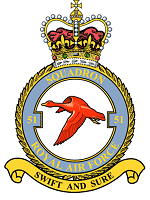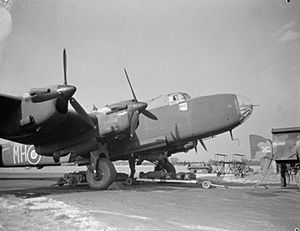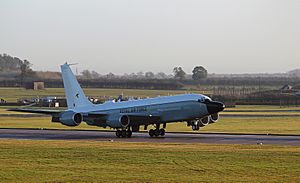No. 51 Squadron RAF facts for kids
Quick facts for kids No. 51 Squadron RAF |
|
|---|---|

Squadron badge
|
|
| Active | 15 May 1916 – 1 April 1918 (RFC) 1 April 1918 – 13 June 1919 (RAF) 5 March 1937 – 30 October 1950 21 August 1958 – present |
| Country | |
| Branch | |
| Type | Flying squadron |
| Role | Signals intelligence |
| Size | Three aircraft |
| Part of | No. 1 Group |
| Home station | RAF Waddington |
| Nickname(s) | 'York's own squadron' |
| Motto(s) | Swift and Sure |
| Aircraft | Boeing RC-135W Airseeker |
| Battle honours |
|
| Insignia | |
| Squadron badge heraldry | A goose volant, chosen as a play on the word 'Anson', the aircraft which the squadron was flying when the badge was being designed, as 'Anser' is the Latin word for Goose, and it was felt that a heavy wild fowl was appropriate for a bomber squadron. Approved by King George VI in December 1937. |
| Squadron codes | UT (Aug 1939 – Sep 1939) MH (Sep 1939 – May 1945) LK (? – Jan 1944) ('C' Flt which became 578 Sqn) C6 (Jan 1944 – May 1945) ('C' Flt) TB (May 1945 – Dec 1949) MH (Dec 1949 – Oct 1950) |
No. 51 Squadron is a special team in the Royal Air Force (RAF). Since 2014, they have flown amazing Boeing RC-135W Airseeker planes, also known as the Rivet Joint. Their home base is RAF Waddington in Lincolnshire, UK.
Before that, from 1974 to 2011, they used the Hawker Siddeley Nimrod R1. When the Nimrod planes retired, the squadron's pilots and crew trained with the United States Air Force to learn how to fly the new RC-135W Rivet Joint planes. The RAF bought these planes as part of a project called Airseeker.
Contents
Squadron History
World War I Missions
No. 51 Squadron started as part of the Royal Flying Corps (RFC) during the First World War. They flew planes like the B.E.2 and B.E.12. The squadron began in Thetford, Norfolk, and later moved its main base to what is now RAF Marham.
Their main job was to protect the UK from German Zeppelin airships. They also used the Avro 504K to teach new pilots how to fly at night. The squadron was temporarily stopped in 1919 after the war ended.
Between the World Wars
The squadron was restarted in March 1937. A part of 58 Squadron became 51 Squadron at Driffield. They flew Virginia and Anson planes.
Around this time, they chose their squadron badge. They picked a goose because the squadron flew the Anson, and the Latin word for goose is Anser. It was also thought that a large wild bird was a good symbol for a bomber squadron.
World War II Missions
No. 51 Squadron was one of the first to act in the Second World War. On the very first night of the war, they dropped leaflets over Germany using their Whitley aircraft.
In February 1942, the squadron took part in a very important mission called Bruneval. Led by the famous Percy Charles Pickard, 51 Squadron used converted Whitley planes to carry 119 paratroopers and an RAF electronics expert to Bruneval, France. The team successfully raided a German radar station. They took parts of a new type of radar, called a Würzburg, back to Britain to study.
After this, the squadron briefly joined Coastal Command. They patrolled the Bay of Biscay to find and fight German U-boats (submarines). In 1942, they switched to flying Halifax planes. For the rest of the war in Europe, 51 Squadron was part of No. 4 Group RAF. They flew many bombing missions against the Nazis from RAF Snaith in East Yorkshire.

After the Wars
After the war in Europe ended, the squadron became part of Transport Command. They used Stirling and later York planes. Their job was to transport soldiers and supplies to places like India and the Far East. The squadron was temporarily stopped again in 1950, but not before helping with the Berlin Airlift.
The squadron was reformed on August 21, 1958, taking over from No. 192 Squadron RAF. They were given a special role called 'Special Duties'. This meant they focused on signals intelligence, which is about gathering information by listening to enemy communications and electronic signals.
They first flew de Havilland Comet planes for this role. In 1974, these were replaced by a special version of the Hawker-Siddeley Nimrod. It wasn't until the end of the Cold War that the squadron's secret signals intelligence work was made public.
One of their three Nimrod planes was retired in 2009. The other two stayed in service until June 2011. These Nimrods were replaced by three Boeing RC-135W Rivet Joint aircraft. In January 2011, people from 51 Squadron started training in the US to learn how to fly the RC-135. They even flew joint missions with the US Air Force while waiting for their new planes.
The first RC-135W (ZZ664) arrived in the UK on November 12, 2013. It began flying missions in 2014, including Operation Shader against ISIL in Iraq and Syria.
Aircraft Flown by the Squadron
Over the years, No. 51 Squadron has flown many different types of aircraft, including:
- B.E.2
- B.E.12
- FE2b
- Martinsyde G.100
- Avro 504K
- Sopwith Camel
- Vickers Virginia Mk10
- Avro Anson Mk1
- Armstrong Whitworth Whitley Mk 2–5
- Handley Page Halifax Mk B2 and B3
- Short Stirling Mk5
- Avro York
- de Havilland Comet Mk2R
- English Electric Canberra B2
- Handley Page Hastings C1
- Hawker Siddeley Nimrod R1
- Boeing RC-135W Rivet Joint
See Also
- Other Nimrod squadrons:
- No. 42 (Reserve) Squadron – Nimrod training unit
- No. 120 Squadron
- No. 201 Squadron
- No. 206 Squadron
- List of Royal Air Force aircraft squadrons
- No. 51 Squadron RAF Regiment



